Coptoformica Ants
Monitoring mound-building ants in wilderness zones: colony dynamics and biocomplexity.
The subgenus Coptoformica MÜLLER, 1923 of the genus Formica LINNAEUS, 1758 is a Palaearctic taxon (SEIFERT 2000). Ten described and two undescribed species are known (SCHULTZ & SEIFERT 2007). They prefer open habitats (often in wooded landscapes) and avoid dark forests or very dense herbaceous vegetation. The Coptoformica ants can be found, inter alia, in cleared areas of the southern taiga zone and the forest-steppe belts of Fennoscandia up to the Far East, but also in steppe areas of Central Asia (SCHULTZ & SEIFERT 2007a). In Europe, cultural landscape transformation (artificial steppes, anthropogenic mosaic landscapes) seems to have had a positive impact on species distribution and abundance patterns (e.g., BLISS & KATZERKE 2004a). However, under current conditions of land use changes, eutrophication of terrestrial ecosystems and climate anomalies the risk of extinction often increases. Conservation action, based on zoogeographic, sociobiological and ecological knowledge, is strongly needed to maintain species diversity (HUGHES 2006). Colonies of the Coptoformica ants are often polydomous and polygynous and can reach huge dimensions of hundreds of nests (BLISS et al. 2001). If they form such supercolonies, the ants act the part of key species and function as ecosystem engineers (BLISS et al. 2006) as well as biodiversity drivers (BLISS et al. 2002).
Research Interests
We are interested in all biological and ecological aspects of the Coptoformica ants, but research is currently focused (BLISS & KATZERKE 2004b) to colony dynamics in the Müritz National Park (Germany, Mecklenburg-Western Pomerania).
Partners
- Prof. Dr. Hilmar Schröder, Humboldt-University Berlin, Institute of Geography
- Müritz National Park Authority
- Jost Reinhold Foundation
Picture Gallery
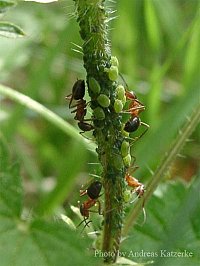
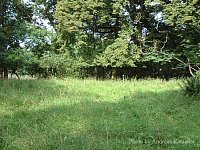
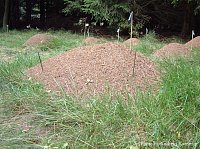
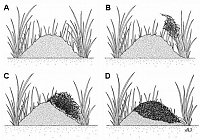
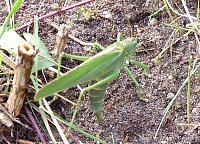
Science meets Amateurs and Conservation Professionals
Much work in myrmecology and species conservation has been done by amateur researchers. The Biological Station “Faule Ort” of the Martin-Luther-University organises “Coptoformica-Workshops” to promote the cooperation of scientists, amateur researches and conservation authorities.
Lectures of the 2006 Faule Ort Workshop
- Zoogeography of the Coptoformica ants in Northeast-Germany - state of knowledge and research needs (Peter Bliss)
- 15 years Müritz National Park - monitoring of ecological processes (Matthias Schwabe)
- Ants of the subgenus Coptoformica in Mecklenburg-Western Pomerania - distribution patterns and abundances (Thilo Busch)
- Ants of the subgenus Coptoformica in the Müritz National Park - distribution patterns, abundances and the hemeroby of ecosystems (Andreas Katzerke & Peter Bliss)
- Formica exsecta in the Müritz National Park - landscape transformation, colony dynamics and bioindication (Peter Bliss & Andreas Katzerke)
- Ants of the subgenus Coptoformica in Brandenburg - distribution patterns and abundances (Bernd Wesenigk-Sturm)
- Formica exsecta nests as microhabitats and the foraging behaviour of F. exsecta workers (Katharina Merkel)
- Zoogeography of the Coptoformica ants in Europe and Asia (Roland Schultz & Bernhard Seifert)
- Are mound-building wood ants suitable as indicators of neogenic tectonics? (Ulrich Schreiber)
Further Reading
- Bliss, P., H. Schröder, A. Katzerke & R.F.A. Moritz (2001): Standort und Struktur eines Kolonieverbandes der Großen Kerbameise (Formica exsecta) im Müritz-Nationalpark (Hymenoptera, Formicidae). - Archiv der Freunde für Naturgeschichte in Mecklenburg XL: 5-23.
- Bliss, P. & A. Katzerke (2004a): Zur Bestandssituation und Gefährdung von Formica foreli im Müritz-Nationalpark nebst Anmerkungen zum Forschungsbedarf (Hym., Formicidae). - Entomologische Nachrichten und Berichte 48 (1): 19-22. Dresden.
- Bliss, P. & A. Katzerke (2004b): Research in untrammeled National Park zones: cultural footprints, natural processes and biodiversity. - Pp. 103-104. In: H. Segers, E. Branquart, A. Caudron & J. Tack (Eds.): Proc. of the 5th meeting of the European Platform for Biodiversity Research Strategy. Scientific Tools for Biodiversity Conservation: Monitoring, Modelling and Experiments. 2-4 December 2001, Brussels. - CD-ROM version.
- Bliss, P., A. Katzerke & P. Neumann (2006): The role of molehills and grasses for filial nest founding in the wood ant Formica exsecta (Hymenoptera: Formicidae). - Sociobiology 47 (3): 903-913. Chico. Bliss, P., A. Katzerke, K. Merkel & M. Wallaschek (2002): Ameisenhügel als Eiablageorte von Heuschrecken (Saltatoria). - Ameisenschutz aktuell 16 (4): 99-105. Scheinfeld.
- Hughes, J. (2006): A review of wood ants (Hymenoptera: Formicidae) in Scotland. - Scottish Natural Heritage Commissioned Report No. 178 (ROAME No. F04AC319), 37 pp.
- Katzerke, A., P. Neumann, C.W.W. Pirk, P. Bliss & R.F.A. Moritz (2006): Seasonal nestmate recognition in the ant Formica exsecta. - Behavioral Ecology and Sociobiology 61: 143-150.
- Schultz, R. & B. Seifert (2007a): The distribution of the subgenus Coptoformica Müller, 1923 (Hymenoptera: Formicidae) in the Palaearctic region. - Myrmecological News 10: 11-18. Vienna.
- Seifert, B. (2000): A taxonomic revision of the ant subgenus Coptoformica Mueller, 1923 (Hymenoptera, Formicidae). - Zoosystema 22 (3): 517-568. Paris.



